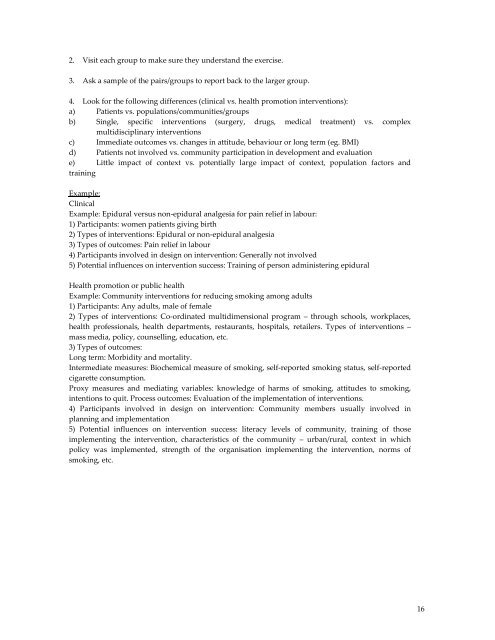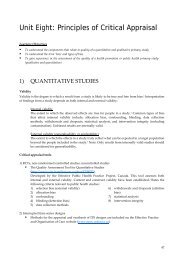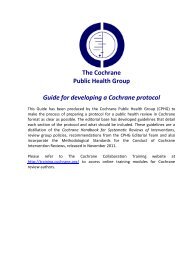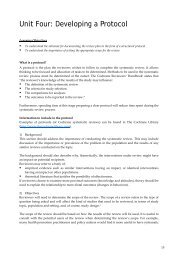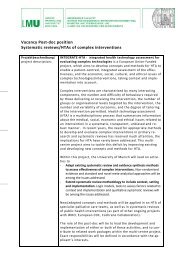Train the Trainer Course book - Cochrane Public Health Group
Train the Trainer Course book - Cochrane Public Health Group
Train the Trainer Course book - Cochrane Public Health Group
Create successful ePaper yourself
Turn your PDF publications into a flip-book with our unique Google optimized e-Paper software.
2. Visit each group to make sure <strong>the</strong>y understand <strong>the</strong> exercise.<br />
3. Ask a sample of <strong>the</strong> pairs/groups to report back to <strong>the</strong> larger group.<br />
4. Look for <strong>the</strong> following differences (clinical vs. health promotion interventions):<br />
a) Patients vs. populations/communities/groups<br />
b) Single, specific interventions (surgery, drugs, medical treatment) vs. complex<br />
multidisciplinary interventions<br />
c) Immediate outcomes vs. changes in attitude, behaviour or long term (eg. BMI)<br />
d) Patients not involved vs. community participation in development and evaluation<br />
e) Little impact of context vs. potentially large impact of context, population factors and<br />
training<br />
Example:<br />
Clinical<br />
Example: Epidural versus non-epidural analgesia for pain relief in labour:<br />
1) Participants: women patients giving birth<br />
2) Types of interventions: Epidural or non-epidural analgesia<br />
3) Types of outcomes: Pain relief in labour<br />
4) Participants involved in design on intervention: Generally not involved<br />
5) Potential influences on intervention success: <strong>Train</strong>ing of person administering epidural<br />
<strong>Health</strong> promotion or public health<br />
Example: Community interventions for reducing smoking among adults<br />
1) Participants: Any adults, male of female<br />
2) Types of interventions: Co-ordinated multidimensional program – through schools, workplaces,<br />
health professionals, health departments, restaurants, hospitals, retailers. Types of interventions –<br />
mass media, policy, counselling, education, etc.<br />
3) Types of outcomes:<br />
Long term: Morbidity and mortality.<br />
Intermediate measures: Biochemical measure of smoking, self-reported smoking status, self-reported<br />
cigarette consumption.<br />
Proxy measures and mediating variables: knowledge of harms of smoking, attitudes to smoking,<br />
intentions to quit. Process outcomes: Evaluation of <strong>the</strong> implementation of interventions.<br />
4) Participants involved in design on intervention: Community members usually involved in<br />
planning and implementation<br />
5) Potential influences on intervention success: literacy levels of community, training of those<br />
implementing <strong>the</strong> intervention, characteristics of <strong>the</strong> community – urban/rural, context in which<br />
policy was implemented, strength of <strong>the</strong> organisation implementing <strong>the</strong> intervention, norms of<br />
smoking, etc.<br />
16


